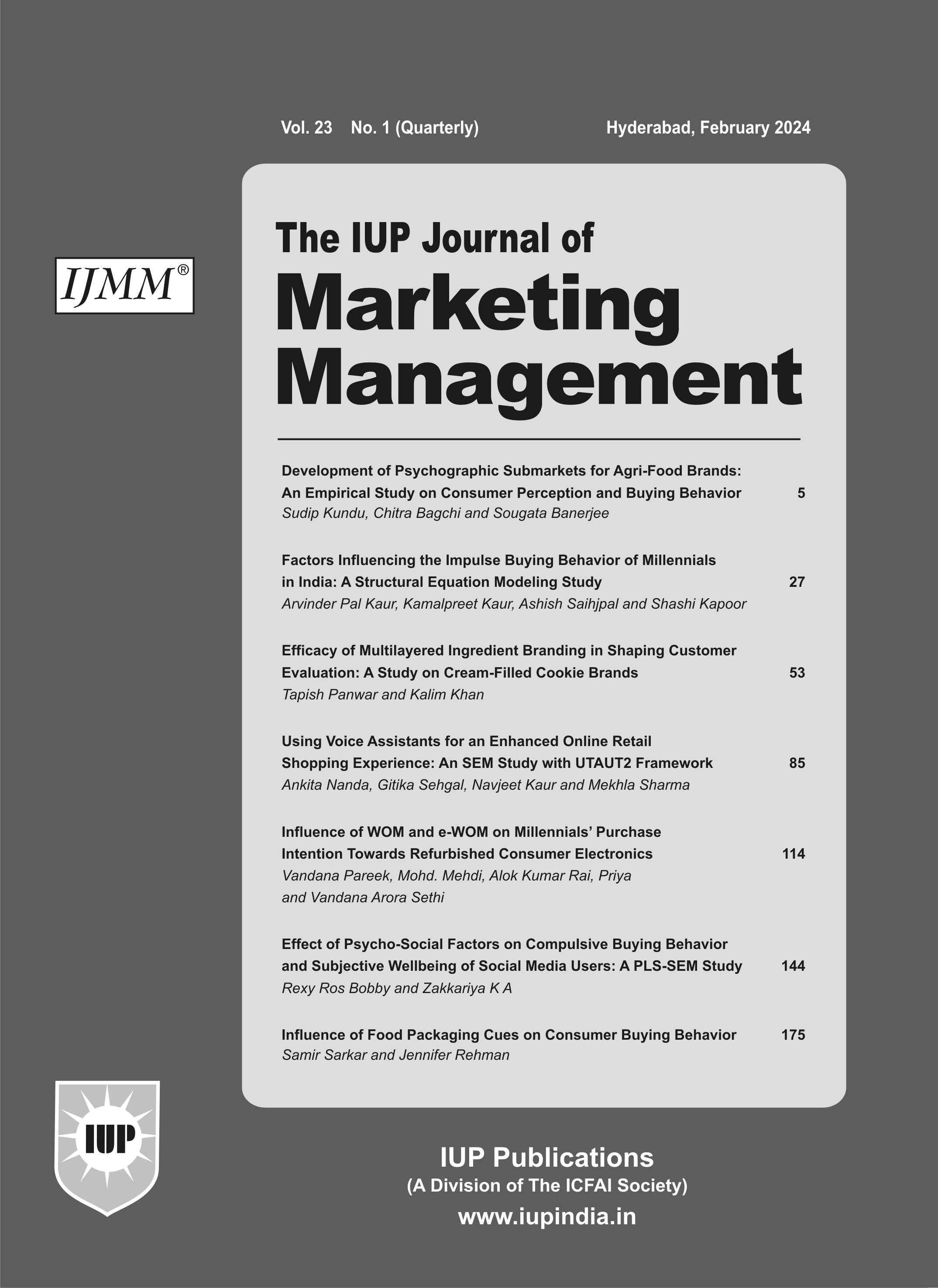
Feb '18
The IUP Journal of Marketing Management
Archives
In-Store Shopping Environment and Impulsive Buying with Special Reference to Indore City
Nidhi Jhawar
Assistant Professor,
IPS Academy,
Institute of Business Management & Research,
Indore, Madhya Pradesh, India.
E-mail: nidhijhawar@ipsacademy.org
Vivek S Kushwaha
Director,
IPS Academy,
Institute of Business Management & Research,
Indore, Madhya Pradesh, India.
E-mail: director.ibmr@ipsacademy.org
The study is based on the objective to identify the influence of in-store shopping environment on the impulsive buying behavior of the customers. The two models of impulse buying—the impulsive decision-making theory and the consumer decision-making model—were studied to validate the study (Schiffman and Kanuk, 2007). Adopting the method of convenience sampling, 300 shoppers at D-Mart and Treasure Island of Indore city were considered for this study. The study revealed that factors that are economic in nature such as free gifts, coupons and price discounts are more likely influences on impulse buying than those with an atmospheric engagement effect like background music, in-store display and salesforce.
Introduction
The dynamism of consumer taste, consumption patterns and buying attitude is enhancing the retail business globally. South Africa, in particular, has of late seen the growth of large supermarket conglomerates such as Pick ‘n Pay, Spar, Checkers, Shoprite and OK. As Marx and Erasmus (2006) state, "These retailers, have since made way for retail giants whose shops occupy 100 sq/m and draw thousands of customers, pushing gigantic trolleys through long alleys in seemingly never-ending shopping malls. The supermarkets are often located within close proximity of one another, although they stock more or less the same goods”. The sustainability of today’s retail business fundamentally depends upon how creatively organizations understand the consumer and develops their marketing mix activities accordingly. Despite other outdoor marketing activities, in-store developments like displays and promotion, background music, supportive staff and kids’ engagement activities are the mechanism to encourage the consumer to spend more time in the store. In-store promotion activities help dig deeper for unplanned purchases for which a new term 'Impulse Buying' has been coined. Impulse buying is pushing revenues by knotting the customers with modern state-of-the-art attractions in the form of offering a beautiful ambience, fresh air, display at point of purchase and hospitality.
Gutierrez (2004) described a planned purchase as a deliberate, thoughtful search and evaluation that normally results in rational, accurate and better decisions. Contrary to a planned purchase, the concept of impulsive buying is both complex and paradoxical. Impulse buying defined as an unplanned purchase, the unplanned purchase can be done due to various in-store factors that are discussed in this paper. Chien-Huang and Hung-Ming (2005) describe impulsive buying as a more arousing, unintended, less deliberate and more irresistible buying behavior as compared to planned buying behavior, with higher impulsive buyers being more likely to be unreflective, to be emotionally attracted to the object and to desire immediate gratification. In a closely related definition, Bayley and Nancarrow (1998) define impulsive buying as a sudden, compelling, hedonically complex buying behavior in which the rapidity of an impulse decision process precludes thoughtful and deliberate consideration of alternative information and choices. These definitions tried to capture all the complexity of the impulse buying such as understanding unplanned action and on the spot reaction of buyer for those purchases not inked in the shopping list.
Literature Review
Various studies have been conducted to find out the impulse buying behavior of the customers. The researches helped to understand the attributes that drive the consumers for impulse purchase, demographic variables responsible and contribution of in-store activities for the same. Table 1 shows a detailed literature review to understand the concept with the help of previous researches.
The In-Store Shopping Environment as a Determinant of Impulse Buying
As discussed in the literature, in-store shopping atmosphere intensely affects the impulse buying behavior of the shoppers. The present study depicts that impulse purchase is comparatively much higher. Zhou and Wong (2004) categorized the in-store shopping environment into two categories:
- In-store promotion is in the form of coupons, discounts and gifts.
- In-store atmosphere like store display, salespeople, background music and ventilation.
The Emotional/Impulsive Decision Making Theory and Impulsive Buying
Impulsive buying is grounded and theoretically underpinned within the emotional or impulsive decision making view to consumer decision making by Schiffman and Kanuk (2007). The view explains that emotions and impulse buying are directly connected; feeling of joy, love and fantasy of purchase encourage the shopper towards unplanned purchase. Rather than carefully searching, deliberating and evaluating alternatives before buying, consumers are just as likely to make many of these purchases on impulse, on a whim, because they are emotionally-driven (Schiffman and Kanuk, 2007). Park et al.
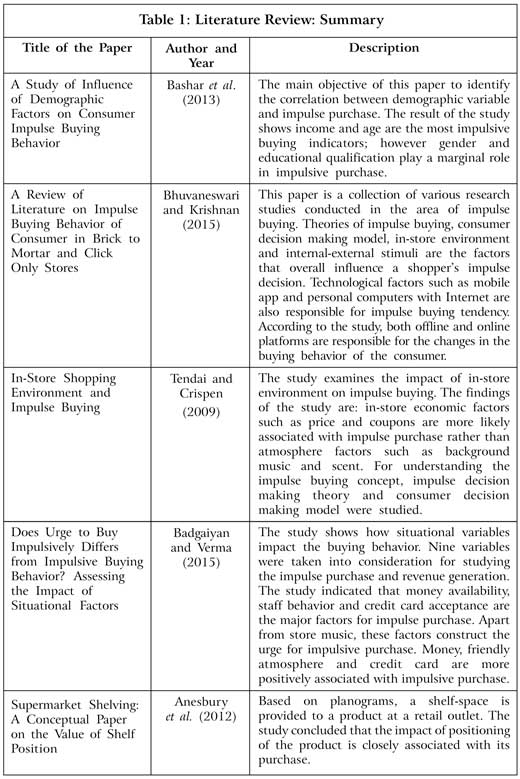
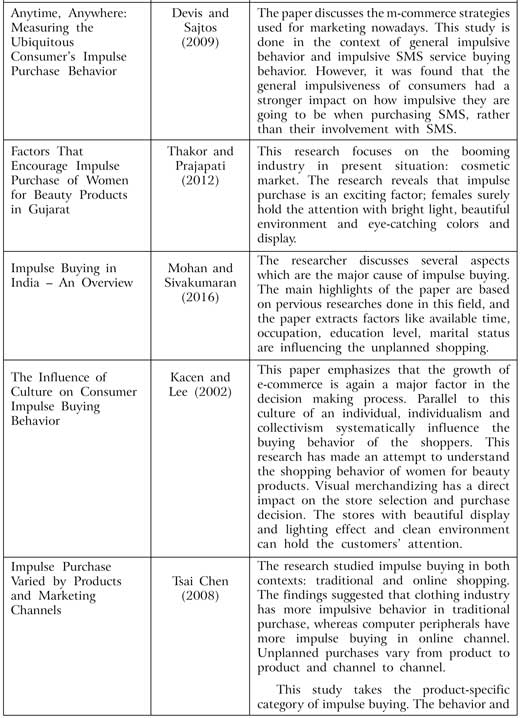
(2005) concluded in their study that retailers can distinguish their image either by offering distinct product of building up the relation with the consumers’ emotional state. All this states that impulse buying is an unplanned purchase derived from a fondness generated through emotional connect of an individual which is beyond his/her control.
The Consumer Decision Making Model
This model focuses on the cognitive approach of consumers’ decision and reflects the emotional aspects of consumer (Schiffman and Kanuk, 2007). According to this model, impulse buying is highly associated with the input components; identified in this model are marketing activities the organization does and socio-cultural belief of an individual. Retail outlets’ marketing activities start from the way they talk about their products which includes packaging, guarantees, in-store promotion activities, discounts and offers. Marketing efforts can be classified into two categories at macro level (mass media) and micro level (in-store promotion). Park et al. (2005) stressed on the importance of retail store promotional activity which encourages the consumer towards impulsive purchase and a well-planned marketing activity to boost the unplanned purchase. Socioeconomic influence consists of family, friends and peers who are non-commercial sources for the impact on impulse purchase (Schiffman and Kanuk, 2007).
In-Store Shopping Environment
Point of purchase is the major determinant because it is the place where ultimately the product and the customer meet. Micro-level marketing strategies, particularly shopping environment such as background music, visual merchandizing, prices, sales personnel and density of store, influence unplanned purchase. Zhou and Wong (2004) also divided the in-store shopping atmosphere into two categories: promotional effect and environmental effect. This categorization is considered for the current study.
The in-store shopping environment is shown in Figure 1.
Factors with a Promotional, Informative and Economic Effect Coupons
The effect of coupons is closely linked to moods, emotions and psychological cognitions (Heilman et al., 2002). In-store instant coupons distribution associated with current
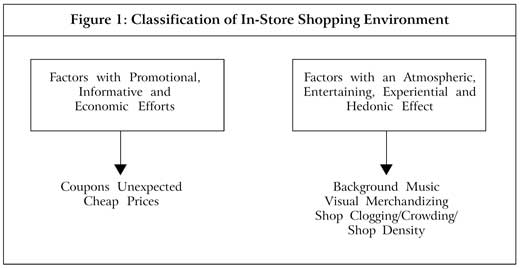
purchase encourages the customer towards instant purchase. Windfall or unanticipated gains are spent more readily than gains that were anticipated, according to Heilman et al. (2002). Coupons are fungible and its redemption will not impact the consumer’s wallet. But these promotional strategies increase the shopping trip to the particular store especially when the redemption is associated with the next purchase. When people are given coupons which can be redeemed at the time of purchase, the customers tend to buy those products no matter whether the product is a part of the shopping list or not. Heilman et al. (2002) referred to these coupons as ‘surprise’ coupons and described them as unanticipated coupons.
Unexpected Cheaper Prices
It is again a windfall for the customer like coupons. One effect of unexpected price discounts is that of causing a generalized affective effect on consumers (Janakiraman et al., 2006). A price hike has a negative effect on spending as it limits shopping, whereas price cuts increase the shopping and customers consider the goods in the shopping list. Unexpected price cuts result in willingness to add unrelated discretionary items. The price changes either increase or decrease the amount planned for a shopping trip and produce congruent spillover effect.
Atmospheric, Entertaining, Experiential and Hedonic Factors Background Music
Previous studies suggested that music impacts the shopping behavior of an individual. Even today, audiences prefer those coffee shops having live music or instrumental background music. Music is capable of evoking complex affective and behavioral responses in consumers, according to North and Hargreaves (1998), as cited by Mattila and Wirtz (2001). Music impacts the time consumers spend at the outlet and spend on purchase too. Studies recommend that slow music stirs up the consumer to spend more time, which in turn increases the purchase too.
In-Store Displays/Visual Merchandizing
Visual merchandizing is very much associated with customer attraction strategy. The most important aspect of successful in-store displays is for retailers to understand their customers and their habits, according to Terrazas (2006). Strategic display is a device for unplanned purchase. The display of most commonly shopped product at the end can be one of the important strategies—this can lead the customer to visit the whole store and confront many other items. Shopping trolleys designed to accommodate kids require strategic trolley height displays that will catch the childrens' attention because children play a big role in shopping trends (Terrazas, 2006). The chances of impulse buying increases when a customer is shopping in the store along with the kids. They are one of the biggest reasons for impulse purchase.
Salespeople
Experienced and supportive customer assistance team can really make a wonderful shopping experience. Extraordinary services make the shopping fun and exciting. Consumers avoid interacting with arrogant as well as interrupting salespersons and appreciate when they get help from sophisticated employees, with regard to sizes and color options (Jones, 1999).
Shop Congestion / Crowding / Shop Density
Generally, people do not prefer shopping at crowded places. Crowding is generally perceived as an unpleasant experience in shopping situations (Bateson and Hui, 1987) as cited by Michon et al. (2005). Consumers postpone purchase, reduce shopping list or move to some other outlets if they find that the place is compact and does not have the right shopping environment; this may reduce the chances of impulse buying.
Objective
To study the in-store shopping environment and its impact on impulse buying behavior.
Hypothesis
In-store shopping atmosphere significantly affects the impulse buying behavior of customers.
Methodology
Quantitative research design is used to conduct this study. Primary data was collected from 300 respondents and the tenure of the data collection was three months, between October to December 2016.
300 respondents from Indore’s D-Mart and Treasure Mall were selected for getting the responses for the study. Convenience sampling technique was used to get the questionnaire filled. Tables below show the demographic profile of the respondents in terms of age and income group.
Age distribution of 300 respondents (frequency, percent, valid percent and cumulative percent of each corresponding group) is provided in Table 2.
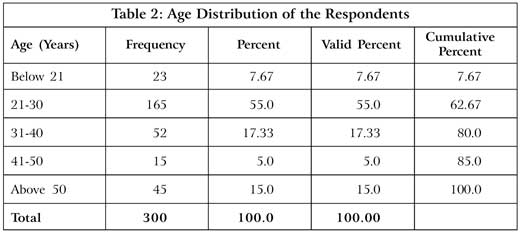
Income distribution of 300 respondents (frequency, percent, valid percent and cumulative percent of each corresponding group) is provided in Table 3.
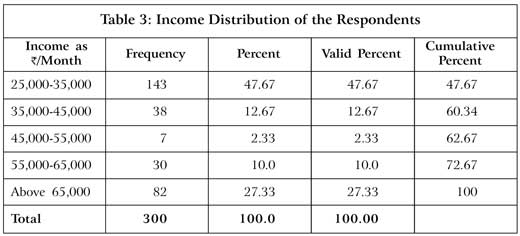
Measuring Instruments
Questionnaire for this Study: A close-ended questionnaire for a standardized response divided into two sections was used to collect data from respondents and it is based on five-point Likert scale.
Reliability Test
To check the reliability of the study, Cronbach's alpha was used. Coefficient of alpha ranges between 0 to 1 and it is considered accepted when value is greater than 0.6 but less than 0.8; value greater than 0.8 is considered good. For the present study, Cronbach alpha’s value is 0.69 which is acceptable.
Research Procedure
Mall intercept technique is used to get the questionnaire from the respondents who were coming out of the supermarket and other stores. The questionnaire was completed and returned to the questionnaire administrator immediately. This helped the respondents to clear their doubts on the spot. Consumers’ likes and dislikes on various in-store factors for impulsive purchase are shown in Figure 2. The vertical axis shows the percentage of likes and dislikes on nine factors which are mentioned on horizontal axis.
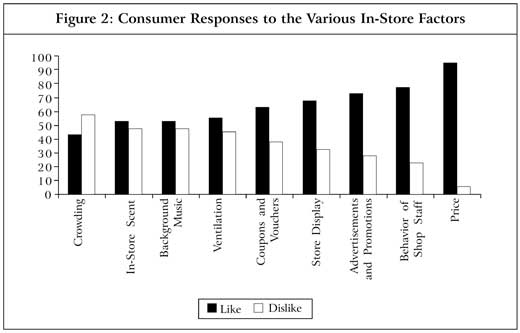
Results and Discussion
As shown in Table 4, crowding at the shop floor plays a negative role in impulsive buying behavior; in-store scent, background music and ventilation are not likely to affect the impulse buying behavior of consumers as indicated by the z test value of –0.951, 0.633, 0.633 and 0.636 respectively. The above non-monetary factors are not exciting the customer to deviate from their shopping list.
The rest of the variables are likely to influence the impulsive buying behavior of consumers. The other factors that influence impulse buying are coupons and vouchers, store display, in-store advertisements, behavior of staff at shop floor and price with z value of 2.363, 1.632, 3.187, 4.165 and 13.059 respectively. Psychological, behavioral and promotional factors like attractive store display, sales team and customer interaction in a respectful and polite manner and promotional technique stimulate impulse buying tendency. Coupons, vouchers and price cuts are the monetary factors having a high impact on impulsive buying behavior. Customers tend to shop more if they have coupons of some store or brand and they not only buy the product in which they get some monetary benefit but deviate from the shopping list as well. Changes in the price of the product is the major variable which contributes to increasing profits of the firm and adding on an unwanted product in customer shopping cart. Discounted price attracts more shopping because with a given amount of money the purchasing capacity of an individual increases.
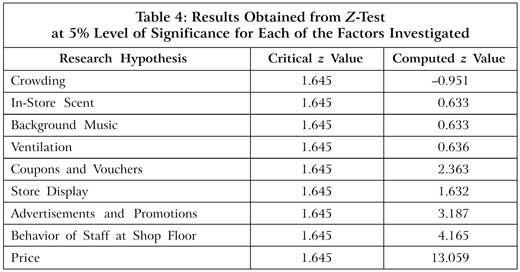
Conclusion
The study concentrated on the relationship between in-store shopping atmosphere and impulse buying. Previous studies worked on one or two variables impacting the impulse buying behavior, while the current study focused on various factors impacting impulse buying. Each factor is discussed briefly and states the percentage level impact on impulsive purchase.
The result shows that coupons and vouchers, store display, advertisements and promotions, behavior of staff at shop floor and price are the major five factors that impact impulsive purchase. Promotional activities like coupons and vouchers contribute significantly in savings. It not only allows savings but sometimes a purchase of premium brand at the same price. Customers tend to buy new products if they have relevant vouchers or coupons. Their shopping decision is quick, and moreover on those products, they save more.
In order to promote sales, retain the existing customer and gain new customer attention, the retailers are constantly working hard for store display and exclusive merchandize at an affordable price. Staff behavior gives a feeling of satisfaction and makes the shopping more enjoyable. Furthermore, companies are trying to bridge the gap between customers and their interaction with its salesforce by appointing well- educated salesforce for better customer satisfaction. This will not only help boost the sales and revenue but also contribute to brand loyalty.
Above all the monetary and non-monetary factors, the important parameter that influences quick purchase is price cut, as it not only boosts the savings of customers but also contributes to bulk purchase. With price benefits, a consumer may avail bulk purchase and they are more open to buying new products if the prices are comparatively less than the substitutes already available in the market. Utilitarian benefit of saving money connects the customer emotionally and tempts impulsive purchase irrespective of the fact whether the product is there in the shopping list or not. Companies can work upon these parameters to attract more and more customers for boosting the sale and revenues. These factors were also identified in an earlier study conducted by Zhou and Wong (2004), as promotional and economic factors impact the sales of the company.
The rest of the four factors, viz., like crowding, in-store scent, background music and ventilation are not supporting the hypothesis as impact factors for impulse purchase. Focusing on the demographic profile of the respondents, most of the respondents are in the age group of 21 to 30 years and with an income of 25,000 to 35,000. The study also found that low income group purchases impulsively due to economic reason and not for hedonic reasons. There are various studies conducted in the area of impulse purchase. Janakiraman et al. (2006) already highlighted that price cuts induced impulsive purchase as it impacts mental accounting activity concept which explains that it either increases or decreases the amount spent on the shopping list during a specific shopping trip. Previous studies also discussed that sales promotional techniques encourage shoppers to buy quickly. The study considered only one of the sales promotional techniques—coupons and vouchers. Future studies can draw upon all the sales promotional techniques and their impact on impulse buying.
In conclusion, it can be said that in-store shopping atmosphere influences impulsive purchase; price cuts, discounts, coupons and shop floor assistants’ behavior directly impact, and other factors like ventilation, light music and fresh fragrance increase the time a shopper spends in the store or mall, although they do not directly influence the impulse purchase; but when a shopper spends more than the time he or she is supposed to, then there is a chance of shopping more than the listed ones. Donovan et al. (1994) suggested that spending is likely to increase when consumers stay longer in a retail environment.
The present study discusses the factors that impact impulse buying among shoppers which in turn increases company’s sales and revenues. Retailers may work upon the pricing strategies for increasing the sales volume besides some in-store season sale for repeat visit of consumers. Staff training should be given in such a way that their behavior with the consumer may also contribute towards impulse purchase. It is equally important for the shoppers to work upon promotional mix strategies for communicating the offers to the customers on time so that they can make the best out of the available monetary resources. In this competitive scenario, only those companies and retail outlets that are constantly working upon customer expectation and providing them an enjoyable shopping atmosphere, flourish (Gutierrez, 2004).
Limitation of the Study: The sample of the current study majorly falls under the middle income group category and they cannot be representative of all the customers. Another limitation is that the sample of the study majorly falls under the age group of 21 to 30 years and they might not be representative of other age groups. Future studies can be conducted with a focus on specific product category because the current study is not product-specific but considered consumers majorly from supermarket and other stores. Further, research can be conducted on electronic equipments and gadgets, fashion and accessories in a more specific manner.
References
- Anesbury Z, Dawes J, Kennedy R and Nenycz-Thiel M (2012), Supermarket Shelving: A Conceptual Paper on the Value of Shelf Position, Australia and New Zealand Marketing Academy.
- Badgaiyan Anant J and Verma Anshul (2015), "Does Urge to Buy Impulsively Differs from Impulsive Buying Behavior?”, Assessing the Impact of Situational Factors, Vol. 22, pp. 145-157.
- Bashar Abu, Ahmad Irshad and Wasiq Mohammad (2013), "A Study of Influence of Demographic Factors on Consumer Impulse Buying Behavior”, International Journal of Marketing and Management, Vol. 4, No. 3, pp. 64-76.
- Bateson John E G and Hui Michael (1987), "A Model for Crowding in the Service Experience: Empirical Findings,” in J A Czepiel, C A Congram and J Shanahan (Eds.), Integration for Competitive Advantage, American Marketing Association, Chicago.
- Bayley G and Nancarrow C (1998), "Impulse Purchasing: A Qualitative Exploration of the Phenomenon, Qualitative Marketing Research”, An International Journal, Vol. 1, No. 2, pp. 99-114.
- Bhuvaneswari V and Krishnan Jaysree (2015), "A Review of Literature on Impulse Buying Behavior of Consumer in Brick to Mortar and Click Only Stores”, International Journal of Management Research and Social Science, Vol. 2, No. 3, pp. 84-90.
- Chien-Huang L and Hung-Ming L (2005), "An Exploration of Taiwanese Adolescents’ Impulsive Buying Tendency”, Academic Journal Article, Adolescence, Vol. 40, pp. 198-209.
- Devis Robert and Sajtos Laszlo (2009), "Anytime, Anywhere: Measuring the Ubiquitous Consumer’s Impulse Purchase Behavior”, International Journal of Mobile Marketing, Vol. 4, No. 1, pp. 15-22.
- Donovan Robert J, Rossiter John R, Marcoolyn Gilian and Nes dale Andrew (1994), "Store Atmosphere and Purchasing Behavior”, Journal of Retailing, Vol. 70, No. 3, pp. 283-294.
- Gutierrez B P B (2004), "Determinants of Planned and Impulse Buying: The Case of the Philippines”, Asia Pacific Management Review, Vol. 9, No. 6, pp. 1061-1078.
- Heilman C M, Nakamoto K and Rao A G (2002), "Pleasant Surprises: Consumer Response to Unexpected In-Store Coupons”, Journal of Marketing Research, Vol. 39, No. 2, pp. 242-252.
- Janakiraman N, Meyer R J and Morales A C (2006), "Spillover Effects: How Consumers Respond to Unexpected Changes in Price and Quality”, Journal of Consumer Research, Vol. 33, No. 3, pp. 361-369.
- Jones M A (1999), "Entertaining Shopping Experiences: An Exploratory Investigation”, Journal of Retailing and Consumer Service, Vol. 6, No. 3, pp. 129-139.
- Jones Michale A, Reynolds Kristy E, Wenu Seungoog and Beatty Sharon (2003), "The Product Specific Nature of Impulse Buying Tendency”, Journal of Business Research, Vol. 56, No. 7, pp. 505-511.
- Kacen Jacquelin J and Lee Julie Anne (2002), "The Influence of Culture on Consumer Impulse Buying Behavior”, Journal of Consumer Psychology, Vol. 12, No. 2, pp. 163-176.
- Mattila A S and Wirtz J (2001), "Congruency of Scent and Music as a Driver of In-Store Evaluations and Behavior”, Journal of Retailing, Vol. 77, No. 2, pp. 273-289.
- Marx N and Erasmus J M M (2006), "An Evaluation of the Customer Service in Supermarkets in Pretoria East, Tshwane Metropolis, South Africa”, Journal of Family Ecology and Consumer Science, Vol. 34, pp. 56-62.
- Michon R, Chebat J C and Turley L W (2005), "Mall Atmospherics: The Interaction Effects of the Mall Environment on Shopping Behavior”, Journal of Business Research, Vol. 58, No. 5, pp. 576-583.
- North Adrian C and Hargreaves Daviid J (1998), "The Effect of Music on Atmosphere and Purchase Intentions in a Cafeteria”, Journal of Applied Social Psychology, Vol. 28, No. 24, pp. 2254-2273.
- Park E J, Kim E Y and Forney J C (2005), "A Structural Model of Fashion-oriented Impulse Buying Behavior”, Journal Fashion Marketing and Management, Vol. 10, No. 4, pp. 433-446.
- Schiffman L G and Kanuk L L (2007), Consumer Behaviour, 9th Edition, Pearson Prentice Hall, New Jersey.
- Tendai Mariri and Crispen Chipunza (2009), "In-Store Shopping Environment and Impulse Buying”, African Journal of Marketing Management, Vol. 1, No. 4, pp. 102-108.
- Terrazas M (2006), "In-Store Displays that Work”, The Baker, Vol. 10, No. 3.
- Thakor Mital and Prajapati Sandeep K G (2012), "Factors that Encourage Impulse Purchase of Women for Beauty Products in Gujarat”, International Journal of Research in Commerce, Economics and Management, Vol. 2, No. 9, p. 101.
- Tsai Chen (2008), "Impulse Purchase Varied by Products and Marketing Channels”, Journal of International Management Studies, pp. 154-161.
- Zhou L and Wong A (2004), "Consumer Impulse Buying and In-Store Stimuli in Chinese Supermarkets”, Journal of International Consumer Marketing, Vol. 16, No. 2, pp. 37-53.